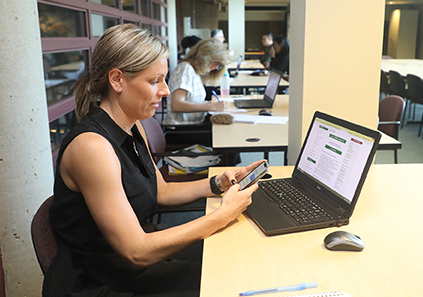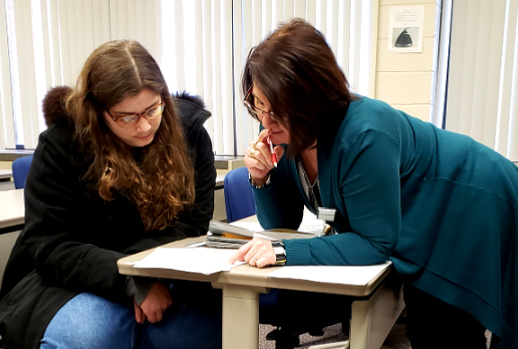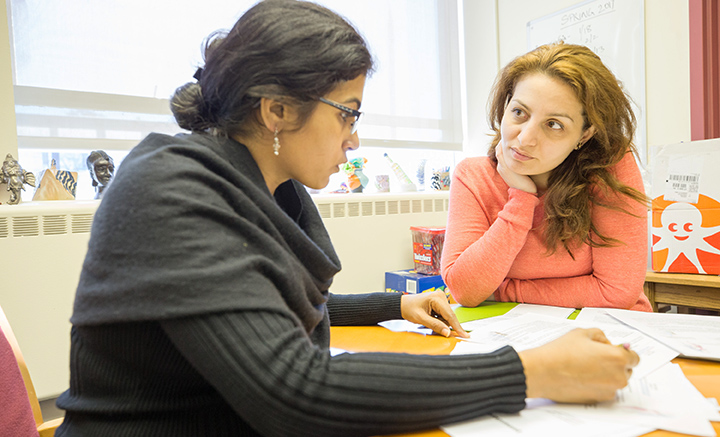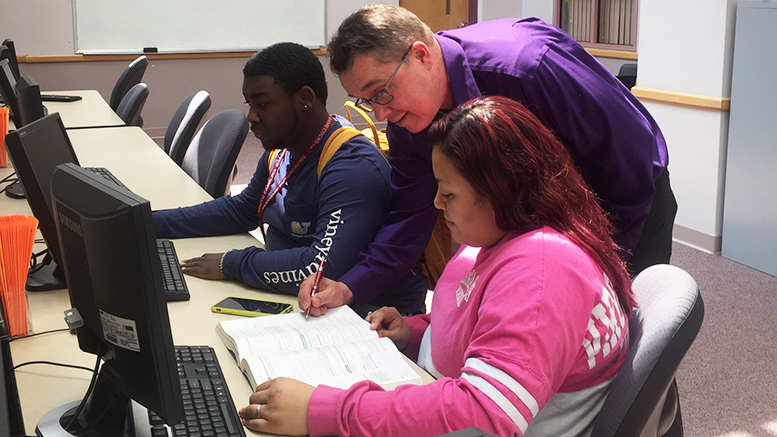For community colleges trying to retain every student, summer is a precarious season when many high school graduates who plan to enroll in the fall don’t follow through. Current students who take the summer off, often fail to come back, too.
“Summer melt is a perennial issue in the community college environment,” says Sara Enright, vice president of student affairs at the Community College of Rhode Island (CCRI).
According to Education Northwest, some community colleges have attrition rates as high as 40 percent. Another study found that offering high school graduates who intend to go to college two or three hours of additional summer support increased enrollment by 3 percent to 4 percent – and 8 percentage points among low-income students.
Colleges have fought back against summer melt by bringing potential students to campus for small-group workshops, engaging students through personal contacts and sending automatic reminders throughout the summer.
Using text messages
CCRI has shifted its summer outreach efforts away from traditional methods – such as relying on high school guidance counselors and paper mailings – and, like a growing number of community colleges, toward text messages and social media.
“We have to meet students where they are. And for young adults, that is online,” Enright says.
Outreach is more critical than ever – both to recruit new students and hang on to existing ones – as CCRI has seen declines in enrollment for the past six years, Enright says. She points to two factors for the decline: a robust labor market and a declining high school population.
Many high school graduates who have expressed an interest in community college, especially if they would be the first in their family to consider college, are likely to spend their summer working long hours, Enright says. They appreciate text messages from the college as a quick way to remind them about course registration deadlines and the need to complete their financial aid application.
“We make sure to have a positive first connection and give them a sense of purpose and a concrete goal that they are going to be motivated to go after,” Enright says. “Ultimately, it’s about building strong and positive relationships with students.”
More touch points

Megan Mardo, a student development counselor at the Community College of Rhode Island, uses texting to engage current and prospective students. (Photo: CCRI)
CCRI uses the Signal Vine app to create automated, targeted texts to certain groups, and staff is trained on how to craft effective messages, says Gregory LaPointe, the college’s executive director of strategic initiatives.
As an example, CCRI just sent a personalized text to 4,000 applicants who haven’t completed their federal student aid application and got back 400 responses with various questions. At this appoint, advisers answer each question individually, Enright says; the next step is using artificial intelligence to respond more quickly.
The college uses geo-fencing to target messages to potential students within a geographic area, such as high school students in certain Providence neighborhoods where the number of incoming CCRI students has declined.
CCRI also uses data to target advertising on Facebook, Instagram and Spotify to certain populations and locations. The college knows if someone clicked on an ad, it can send to that person a text reminder that it’s not too late to register for the fall semester.
“An in-person touchpoint is best,” Enright says, but because “our students are extremely busy,” CCRI started using videos this summer as another way to reach out. The college sends texts telling students “we can’t wait to see you in September” with links to a short video on CCRI’s YouTube channel designed to inspire them to register.
Most students visit the college only one to three times before they enroll, but “with video and other messaging, you have 15 points of contact in the summer,” Enright says.
The challenge is to be welcoming to future students without overwhelming them with too many texts.
“We’re working really hard not to bombard students. We don’t want them to tune out, so we’re working to strike the right balance,” Enright says.
In addition to online engagement, CCRI hosts “welcome days” during the summer for incoming students, a structured bridge program for first-generation students, and a Gateway to Success program before the start of the fall semester for those who need academic support in math, reading and writing. There are also Promise Enrollment Days during the summer for students receiving Promise scholarships that showcase all the resources available at CCRI.
Strong personal relationships
Eastern Gateway Community College (EGCC) in Ohio combats summer melt by fostering in-person relationships with potential students. The college has three separate federally funded TRIO programs to help disadvantaged students enroll in and stay in college by providing extra help with academics, career exploration and information on resources.

An Eastern Gateway Community College student gets help from an advisor at a TRIO Student Support Services Center. (Photo: EGCC)
A TRIO Upward Bound program based on the Steubenville campus offers a summer program to students in grades 9-12. Students who’ve participated in college activities are more likely to enroll after they graduate, says Ty-Juan Young-Bright, assistant dean of academics.
The TRIO Educational Center at the Youngstown campus helps students apply for financial, get transcripts and other documents, and apply to any college in the country. Most people who come to that center end up enrolling at EGCC after they develop “a good relationship with staff at the college who really care about them,” Young-Bright says.
Once enrolled, EGCC students can visit a TRIO Student Support Services Center at each campus for additional help to get onto a career pathway and make plans to earn an associate degree and transfer to a four-year institution.
All incoming students at EGCC are required to take a Succeeding in College course for credit, and that course is also offered during the summer to give new students a head start.
Staff is available all summer to meet prospective students, take them on campus tours, give them assessments to help them choose a career path and match them with graduates for job-shadowing experiences. Incoming students are invited to open houses and orientation sessions where they not only have a chance to become familiar with the campus and college procedures, but also hear inspirational stories from former students with good careers.
EGCC also has a robust online instructional program, so the college encourages students who are taking the summer off to sign up for at least one online course to keep up the momentum and graduate sooner.
“It’s the relationships students build with faculty and staff that keep them intrigued to stay here and not quit,” Young-Bright says.
Free summer classes
The Alamo Colleges District in Texas battles summer melt by inviting students who complete 24 hours during the spring and fall semesters with a “C” or better in each course to take six credit hours in the summer at no cost.
“That helps them complete faster and keep the momentum going” while also increasing summer enrollment, says Adelina Silva, vice chancellor for student success.
More than half of the students eligible for the Summer Momentum program took advantage of it, Silva says. This is just the program’s second summer but already “it’s moving the needle on graduation rates,” she says.
To keep students engaged all year long while staying on track toward completion, each Alamo student is assigned a transfer advisement guide that helps them create a plan for earning a degree within a certain amount of time. A student’s Individual Success Plan outlines the courses needed in each semester, including the summer session.
Every student meets with an adviser “at certain milestones and touchpoints as we nudge you along to completion,” Silva says. By the 30th hour, students have to decide where they want to transfer, so their degree plan is aligned with the courses needed for that university – and students don’t waste time taking courses they don’t need.
To address summer melt among recent high school graduates, Alamo Colleges highly recommends they sign up for a free summer bridge program. It covers time management, leadership and a math refresher or developmental math.
“We want the students to be college ready,” Silva says. “We also want the colleges to be student ready.”
Many ways to connect
Norwalk Community College (NCC) in Connecticut also uses the Signal Vine app to send texts to prospective students in the summer to advise them of the registration procedure, how to apply for financial aid and to answer questions, says Mike Butcaris, interim dean for academic affairs.
Last summer, NCC began inviting potential students to small-group Panther Advising Workshops, named for the college mascot. There are multiple PAW sessions a week, with 18 to 20 students at each one. The sessions cover the college’s student records system, accessing the library and using the college’s online portal.
At the end of the workshop, students are immediately taken through the class registration process.
NCC has two full-time retention specialists who run the workshops and stay personally connected to students throughout the summer and after they enroll. They answer questions and make sure students have all the documents they need, such as immunization records.
Among students who went to a PAW session, 95 percent registered, which is more than the rate of students who only attended a larger advising session. They also reported a more positive experience at college after they enrolled.

Norwalk Community College Career Development Director Kiran Somaya advises a student. (Photo: Richard Freeda/NCC)
Norwalk students who serve as ambassadors assist with the PAW sessions and help students register and learn the ropes.
“New students might feel more comfortable asking them questions rather than waiting to make an appointment with a college official,” Butcaris says.
NCC has a two-week summer bridge program in math for incoming students who need to brush up their skills to get into college-level math. Students who completed the program and were placed in a college-level course have passed that course at higher rates than students who didn’t initially need developmental math.
“The summer bridge experience creates a sense of belonging and peer connections,” says math chair Eli Glatt, who coordinates the program. Even students who aren’t able to move up to a college-level math course are part of a cohort and are more likely to participate in clubs or activities the first year.
Norwalk also has as a federally funded TRIO program that provides a free summer math course to students who’ve completed their first year of college and meet certain income and other requirements.
“That’s tremendously beneficial,” Butcaris says. “Students who’ve gone through a year of college appreciate a course that gets them closer to their degree.”
In addition, NCC’s continuing education division offers a “college for kids” program during the summer, mostly for students in grades 1-12, with a wide range of courses, such as computer coding, environmental science and culinary skills.
The program not only “keeps their minds active and keeps them learning,” Butcaris says, it also encourages young students to think about college and career possibilities, feel comfortable on campus and keeps NCC in their minds for the future.

